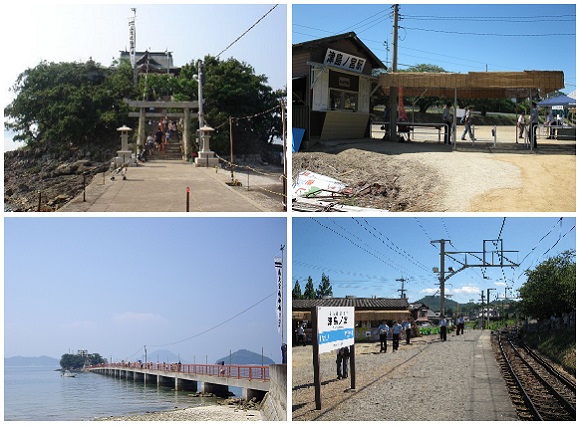
Without a doubt, one of the things Japan is best known for is trains. And it’s not just marketing hype either–public transportation is apparently good enough to accommodate the decreasing number of Japanese youth getting driver’s licenses. But while most trains can be counted on to run from 5 am to 1 am every day of the week in the cities, that’s not always the case in rural areas.
Take Tsushima no Miya station in Kagawa Prefecture, for example, where the train has the most limited schedule in the country: It’s only open two days out of the year!
Shikoku, an island with four prefectures just south of the mainland of Japan, certainly fits the bill when it comes to “rural” with a population of just over four million people spread around Ehime, Kagawa, Kōchi, and Tokushima Prefectures. Which means that many of the train lines run on much more limited schedules than urban places like Tokyo.
▼Shikoku, indicated in off-brown
However, most trains still manage to run a fairly regular schedule, making it possible for residents and travelers to get around the island. Tsuhi no Miya Station, on the Yosan Line in Kagawa Prefecture, is the notable exception. Open only two days a year, August 4 and 5, the station serves but one function: To help people get to Tsuhima Jinja, a shrine built on a small rock island in the middle of the bay. But if it’s the only station serving the shrine, why in the world is it open only two days a year??
▼Tsuhima Jinja, not an easy place to get to
First, a bit of history about the island shrine. Tsushima Jinja was primarily seen as offering protection for cattle during the Edo period, after a disease killed much of the cattle in Japan, but left the local animals unscathed. However, in the Taisho period, many parents came to the shrine to pray for their children, seeking to protect them from disease. While that might seem like a bit of a wild connection, is there really that big of a difference between raising calves and raising children? According to my mother after seeing my room, not really.
▼”Moooom, you just don’t understand me!”
However, the shrine isn’t open for visitors just any day of the year. If you’re looking for some spiritual protection for your child, you’ll have a very narrow window of time to stop by the shrine each year–like the train station, it’s only accessible to the public during the summer festival on August 4 and 5. We suppose the deity is busy protecting everyone’s children the rest of the year, so it makes sense.
But, wait, how do they keep people off the island? Well, in the past, people used to cross over to the island shrine by boat, but now a lengthy foot bridge is available to worshipers.
Since the bridge is the only way people can get across without a boat, a simple but clever method is used to deter mischievous youth and other troublemakers from trespassing on the island for the other 363 days a year. They take out the planks!
▼”You shall not pass!” Gandalf should have thought of this…
Of course, since the shrine and station are only open for a scant 48 hours, the station itself isn’t much to look at. In fact, the ticket counter looks more like a tool shed than a station!
▼This is the “platform.” Watch your step!
While the facilities are certainly very…um…quaint, it honestly seems like a bit of overkill. After all, just a single tent seems like all you would need for a station that’s only used two days a year. Except that over those two days, the shrine gets over 10,000 visitors. Which is like having a Tokyo anime convention on a tiny island in the middle of the ocean…
Of course, the station is also a hot spot for tecchan, Japan’s train otaku, who love to collect tickets from all over the country. We can imagine that adding a Tsushima no Miya station ticket to your collection would be a major point of pride for many of our locomotive-loving friends!
So, if you’re looking for something to do this summer, why not head down to Shikoku and visit the shrine? At least you’ll be doing all your waiting in line in the middle of some beautiful scenery!
Sources: Japaaan, Wikipedia (Tsushima no Miya Station), Wikipedia (Tsushima Jinja), Mitoyo City
Images: Mitoyo City, Wikipedia (Toto-tarou), Wikipedia (Unamu), Wikipedia (LERK), Wikipedia (Jim Champion)

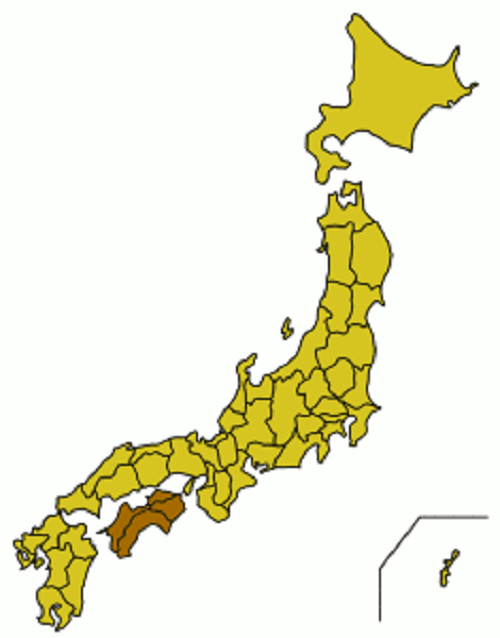
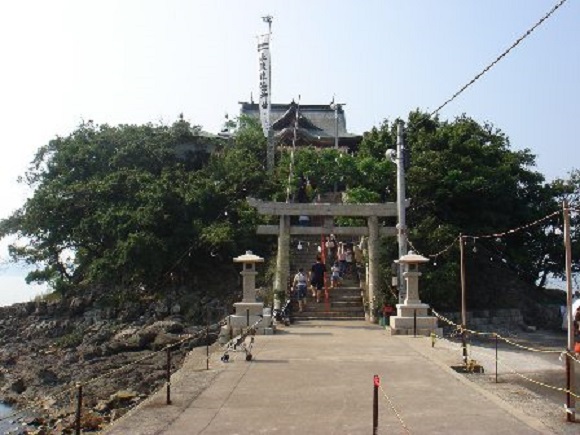

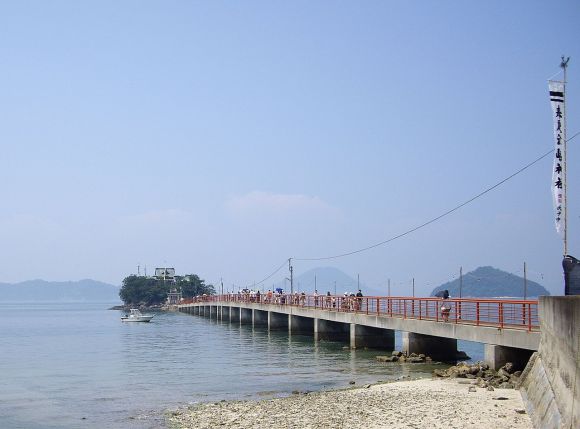
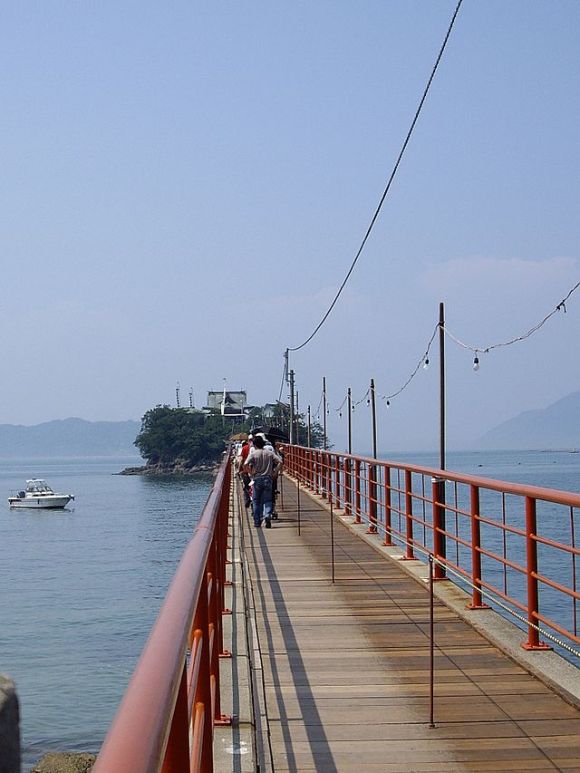

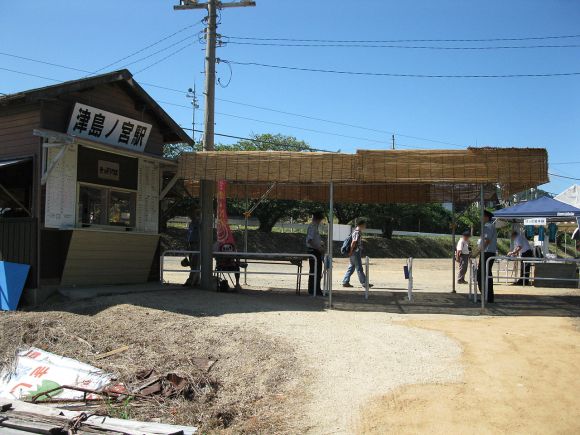
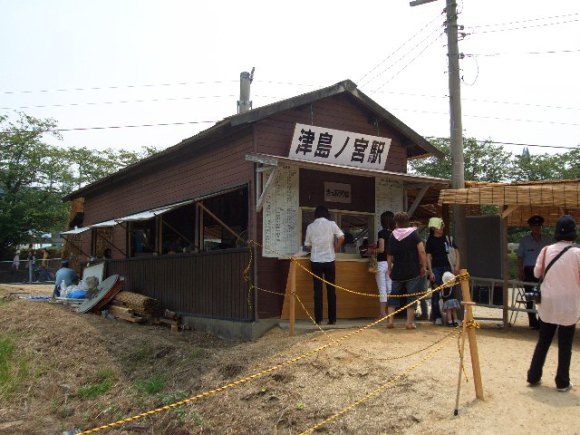
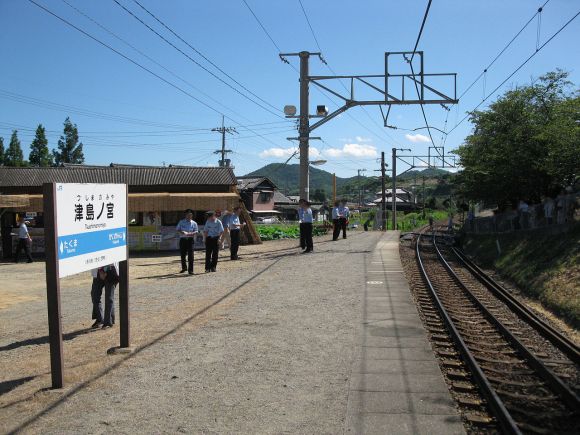
 Breathtakingly beautiful beach in often-overlooked part of Japan is like a scene out of Your Name
Breathtakingly beautiful beach in often-overlooked part of Japan is like a scene out of Your Name 12 beautiful Japanese train stations by the sea
12 beautiful Japanese train stations by the sea Test your knowledge of Ghost of Tsushima’s geography and enter a drawing for a mystery prize
Test your knowledge of Ghost of Tsushima’s geography and enter a drawing for a mystery prize Japanese prefecture that named a Pokémon as its governor to install 16 new Pokémon manholes
Japanese prefecture that named a Pokémon as its governor to install 16 new Pokémon manholes New ‘Shrine Cafe’ in Tokyo offers fortune-telling and counseling services with your tea
New ‘Shrine Cafe’ in Tokyo offers fortune-telling and counseling services with your tea McDonald’s new Happy Meals offer up cute and practical Sanrio lifestyle goods
McDonald’s new Happy Meals offer up cute and practical Sanrio lifestyle goods Super Nintendo World expansion gets delayed for several months at Universal Studios Japan
Super Nintendo World expansion gets delayed for several months at Universal Studios Japan Studio Ghibli glasses cases let anime characters keep an eye on your spectacles
Studio Ghibli glasses cases let anime characters keep an eye on your spectacles All-you-can-drink Starbucks and amazing views part of Tokyo’s new 170 meter-high sky lounge
All-you-can-drink Starbucks and amazing views part of Tokyo’s new 170 meter-high sky lounge Beautiful Sailor Moon manhole cover coasters being given out for free by Tokyo tourist center
Beautiful Sailor Moon manhole cover coasters being given out for free by Tokyo tourist center Kyoto’s 100 Demons yokai monster parade returns!
Kyoto’s 100 Demons yokai monster parade returns! Mister Donut ready to make hojicha dreams come true in latest collab with Kyoto tea merchant
Mister Donut ready to make hojicha dreams come true in latest collab with Kyoto tea merchant More foreign tourists than ever before in history visited Japan last month
More foreign tourists than ever before in history visited Japan last month My Neighbour Totoro kimono coat sells out as soon as it’s released by Studio Ghibli in Japan
My Neighbour Totoro kimono coat sells out as soon as it’s released by Studio Ghibli in Japan Randomly running into a great sushi lunch like this is one of the best things about eating in Tokyo
Randomly running into a great sushi lunch like this is one of the best things about eating in Tokyo Disney princesses get official manga makeovers for Manga Princess Cafe opening in Tokyo
Disney princesses get official manga makeovers for Manga Princess Cafe opening in Tokyo Starbucks reopens at Shibuya Scramble Crossing with new look and design concept
Starbucks reopens at Shibuya Scramble Crossing with new look and design concept Beautiful new Final Fantasy T-shirt collection on the way from Uniqlo【Photos】
Beautiful new Final Fantasy T-shirt collection on the way from Uniqlo【Photos】 Is the new Shinkansen Train Desk ticket worth it?
Is the new Shinkansen Train Desk ticket worth it? Foreign English teachers in Japan pick their favorite Japanese-language phrases【Survey】
Foreign English teachers in Japan pick their favorite Japanese-language phrases【Survey】 Japanese convenience store packs a whole bento into an onigiri rice ball
Japanese convenience store packs a whole bento into an onigiri rice ball We try out “Chan Ramen”, an underground type of ramen popular in the ramen community
We try out “Chan Ramen”, an underground type of ramen popular in the ramen community Studio Ghibli releases Kiki’s Delivery Service chocolate cake pouches in Japan
Studio Ghibli releases Kiki’s Delivery Service chocolate cake pouches in Japan Japan’s bone-breaking and record-breaking roller coaster is permanently shutting down
Japan’s bone-breaking and record-breaking roller coaster is permanently shutting down New definition of “Japanese whiskey” goes into effect to prevent fakes from fooling overseas buyers
New definition of “Japanese whiskey” goes into effect to prevent fakes from fooling overseas buyers Our Japanese reporter visits Costco in the U.S., finds super American and very Japanese things
Our Japanese reporter visits Costco in the U.S., finds super American and very Japanese things Studio Ghibli unveils Mother’s Day gift set that captures the love in My Neighbour Totoro
Studio Ghibli unveils Mother’s Day gift set that captures the love in My Neighbour Totoro Foreign passenger shoves conductor on one of the last full runs for Japan’s Thunderbird train
Foreign passenger shoves conductor on one of the last full runs for Japan’s Thunderbird train Domino’s Japan now sells…pizza ears?
Domino’s Japan now sells…pizza ears? New Japanese KitKat flavour stars Sanrio characters, including Hello Kitty
New Japanese KitKat flavour stars Sanrio characters, including Hello Kitty Kyoto creates new for-tourist buses to address overtourism with higher prices, faster rides
Kyoto creates new for-tourist buses to address overtourism with higher prices, faster rides Sales of Japan’s most convenient train ticket/shopping payment cards suspended indefinitely
Sales of Japan’s most convenient train ticket/shopping payment cards suspended indefinitely Sold-out Studio Ghibli desktop humidifiers are back so Totoro can help you through the dry season
Sold-out Studio Ghibli desktop humidifiers are back so Totoro can help you through the dry season Japanese government to make first change to romanization spelling rules since the 1950s
Japanese government to make first change to romanization spelling rules since the 1950s Ghibli founders Toshio Suzuki and Hayao Miyazaki contribute to Japanese whisky Totoro label design
Ghibli founders Toshio Suzuki and Hayao Miyazaki contribute to Japanese whisky Totoro label design Doraemon found buried at sea as scene from 1993 anime becomes real life【Photos】
Doraemon found buried at sea as scene from 1993 anime becomes real life【Photos】 Tokyo’s most famous Starbucks is closed
Tokyo’s most famous Starbucks is closed One Piece characters’ nationalities revealed, but fans have mixed opinions
One Piece characters’ nationalities revealed, but fans have mixed opinions We asked a Uniqlo employee what four things we should buy and their suggestions didn’t disappoint
We asked a Uniqlo employee what four things we should buy and their suggestions didn’t disappoint Princesses, fruits, and blacksmiths: Study reveals the 30 most unusual family names in Japan
Princesses, fruits, and blacksmiths: Study reveals the 30 most unusual family names in Japan Quiz time! How many of these photos of Japanese places can you identify?【Photos】
Quiz time! How many of these photos of Japanese places can you identify?【Photos】 The only path to this Nagasaki Shinto shrine gets swallowed by the sea every day【Video】
The only path to this Nagasaki Shinto shrine gets swallowed by the sea every day【Video】 Take it from a local: This resort island off the coast of Nagasaki is totally worth a side trip
Take it from a local: This resort island off the coast of Nagasaki is totally worth a side trip You can go surprisingly far on a single train leaving from Tokyo Station
You can go surprisingly far on a single train leaving from Tokyo Station Is it a Lawson or a train station? We investigate the mysterious Sekiguchi Station
Is it a Lawson or a train station? We investigate the mysterious Sekiguchi Station $2.34!? Cheapest bullet-train ride in Japan lasts 3 minutes, but memories are forever【Photos】
$2.34!? Cheapest bullet-train ride in Japan lasts 3 minutes, but memories are forever【Photos】 We channel Sen from Ghibli’s Spirited Away and travel to a Japanese train station by the sea
We channel Sen from Ghibli’s Spirited Away and travel to a Japanese train station by the sea Taste the floor of a Japanese train station with new limited-edition chocolates from Tokyo Metro
Taste the floor of a Japanese train station with new limited-edition chocolates from Tokyo Metro Mystery Tourist Spot: Merlions in Japan?
Mystery Tourist Spot: Merlions in Japan? The train station that stayed open for a single school girl finally closes down
The train station that stayed open for a single school girl finally closes down Osaka to Fukuoka for less than 40 bucks? It’s possible with Japan’s overnight ferry
Osaka to Fukuoka for less than 40 bucks? It’s possible with Japan’s overnight ferry Making trains meow-r fun: Japanese station master cats (and bunny!) strut their fluff【Pics】
Making trains meow-r fun: Japanese station master cats (and bunny!) strut their fluff【Pics】 Japan’s new random-destination die-roll train tickets — Amazing bargain for just 36 bucks
Japan’s new random-destination die-roll train tickets — Amazing bargain for just 36 bucks The Japanese train station with torii gates on its tracks
The Japanese train station with torii gates on its tracks Can you spot the hidden cats at this Tokyo train station?
Can you spot the hidden cats at this Tokyo train station?
Leave a Reply